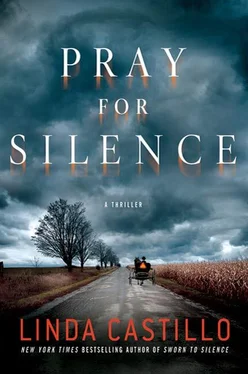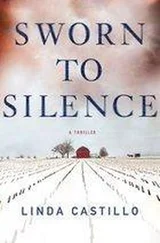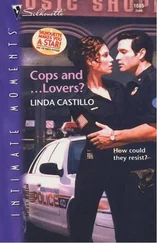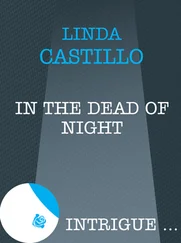“Got a partial print here.” He takes a second shot.
I pull one of the evidence markers from my coat. “Plenty of tread.”
“Looks like a boot. Men’s. Size nine or ten.”
I arch a brow. “You’re good.”
“That’s what my wife says.”
We exchange small smiles, and I’m glad I have him to help me keep things in perspective. I kneel beside him, study the print. It’s a partial, the front half of a shoe or boot. “Where did he pick up that blood?” I wonder aloud.
“Had to have stepped in it somewhere.” Glock glances my way. “I didn’t see any other prints.”
“Gotta be.” I rise, look around, heartened by the promise of evidence.
He shoots a final photo, gets to his feet and we look around. He walks slowly toward the small boy on the other side of the room and snaps a shot.
I go to the nearest body and kneel. It’s not easy looking at a dead teenaged boy. He’s lying facedown, his hands bound behind his back. His head is turned to the side and I see blood in his hair. Bits of brain matter and tiny white bone fragments from his shattered skull spatter the floor. His lips are parted. I see blood between his teeth. The small pink nub of a tongue that’s nearly been bitten off. Though I used the mentholated petroleum jelly, the reek of urine and feces repulses me.
Then I notice the binding at the boy’s wrists and my petty discomforts are forgotten. It’s some type of insulated wire. Speaker wire, I realize. Something an Amish man would never have in his home or anywhere else. The double knots are tied off neatly. The wire is tight enough to cut skin.
The fact that the killer used speaker wire niggles at me as I go to the kitchen. Who would have speaker wire on hand? Someone putting a sound system into their home? Their car or RV? Someone who works with audio or sound systems? Computers maybe? I’m working the possibilities over in my head when Glock calls out.
“I think I found where he picked up that blood.”
I walk to him and he motions down at the dead little boy. “There’s blood on that rug. I’d say the killer stepped on the rug and tracked it.”
He’s right. Disappointment presses into me. “I was hoping we’d find a better print.”
“Never that fuckin’ easy.” He snaps several shots of the blood-soaked rug.
I go to the kitchen and pull the sketch pad from my kit. Back in the living room, I begin a crude illustration of the scene, concentrating on the location and position of each body. I’m not a very good artist, but combined with the photos, this depiction will be a good record of how we found the scene.
I go to Amos Plank’s body. He, too, lies facedown with his head turned to one side. The pool of blood surrounding his head glitters beneath the work light. I kneel next to him. “Glock, did you get photos of the father?”
Lowering the camera, he comes up beside me. “A half dozen or so from different angles.”
That gives me the go-ahead to move the body. “Help me roll him over,” I say.
Squatting next to me, Glock places his hands on the dead man’s left hip. I put my hands on his left shoulder. “Go,” I say and in tandem we roll him onto his back.
A cup or so of blood spills from his mouth when his head lolls. Glock and I move quickly back to avoid getting biohazard on our clothes. Plank’s face goes beyond macabre beneath the stark light. I see several broken teeth. Gray-black powder burns around his lips. Nostrils filled with coagulated blood. Jaw broken, mouth hanging open. A tongue shredded by a bullet.
Livor mortis has set in; the right side of his face is dark purple. Lividity occurs when the heart stops and blood, no longer being pumped, settles to the lowest part of the body. The bruise-like discoloration begins as early as half an hour after death and becomes more pronounced with time. It’s my first clue with regard to his time of death.
“Looks like he’s been dead at least an hour,” I say.
“If people knew what bullets did to their fuckin’ faces, we’d have a hell of a lot less suicides,” Glock comments.
The bullet wound appears to be self-inflicted. It entered via his mouth and exited out the back of his head, shattering his skull and taking a good bit of brain with it. Some might think it an apt end for a man who’d just murdered his family in cold blood.
“If he put the gun in his mouth and pulled the trigger,” Glock begins, “wouldn’t the concussion send him backward? Wouldn’t he land face-up?”
“Usually, that’s the case,” I say. “But if he was leaning forward. Clutching the weapon. Head down.” I ward off a chill the image conjures. “There may not have been enough momentum.”
“Hell of way to go.”
“Why would an Amish man have speaker wire?” I’m mostly thinking aloud. “He probably doesn’t own a stereo or TV. He didn’t even use a milking machine or generator for his dairy operation.”
“Hard to figure.” Glock shrugs. “Maybe he got it on sale somewhere or someone gave it to him. Uses it because it’s strong.”
“He has baling twine in the barn. Why not use that?”
“What are you getting at, Chief?”
I’m not sure how to express the thoughts running through my head without sounding prejudiced. But experience has taught me to listen to my instincts. Right now that little voice in my head is telling me this scene may not be what it looks like.
“I can’t see an Amish man doing this,” I say after a moment.
“The Amish are human, too,” he says. “They have tempers. Limits. They snap.”
He’s right. It’s rare, but the Amish have killed before. In 1993, Edward Gingerich murdered and then eviscerated his young wife. It’s one of only a few documented cases on record.
“This doesn’t add up,” I say. “The level of violence. The handgun. The torture of the daughters. The speaker wire.”
“Hard to swallow when it’s the parent killing his kids.”
Glock is one of the best cops I’ve ever known. He has loads of common sense, good instincts, and enough experience under his belt to know appearances can be deceiving. He’s tough and loyal, sometimes to a fault. Last January, when we were investigating the Slaughterhouse Killer case, he risked his job to support me after I was fired by the town council. Above and beyond the obvious, one of the things I admire most about him is that he will give his honest opinion—even when he knows it’s not what I want to hear.
“Are you telling me you think someone else came in here, shot them, and then made it look as if the father did it?” he asks.
“Sounds like a crazy theory when you put it that way.”
Glock looks down at the body, but I feel the weight of his attention on me. “When I was a stationed in North Carolina, this crazy fucker cut up his kids and put them in a Crock-Pot with sweet potatoes. Later, when the shrink asked the guy why he did it, he told him he loved them too much to let them live.”
“That doesn’t make any sense.”
He shrugs. “That’s my point. You can’t make sense of something that doesn’t, no matter how hard you try.”
I know he’s right. Crimes like this baffle the mind. They break your heart. They’ll tear you up inside if you let them. One of the old timers I worked with as a rookie once told me it’s the cops who spend too much time trying to figure it out who end up going the way of Amos Plank.
“You don’t want to get inside a mind like that,” Glock says. “Talk about a scary fuckin’ place.”
The slamming of the kitchen door garners my attention. I look over to see the coroner, Dr. Ludwig Coblentz, standing in the kitchen, holding a suitcase-size medical bag. Wearing a cream-colored windbreaker over a flannel pajama top and tan Dockers, he looks like a cross between the Michelin Man and the Pillsbury Doughboy. But what he lacks in physical presence, he makes up for by being damn good at what he does. He’s one of five doctors in Painters Mill and has been acting coroner for nearly eight years.
Читать дальше












